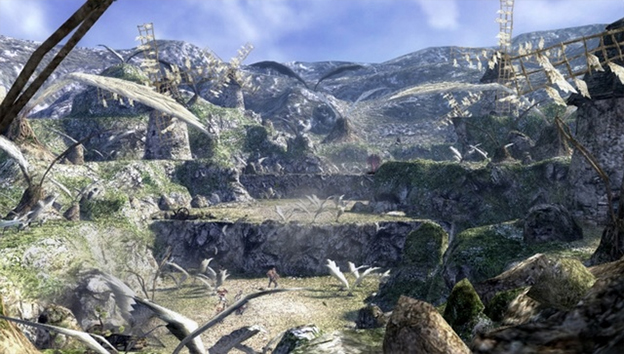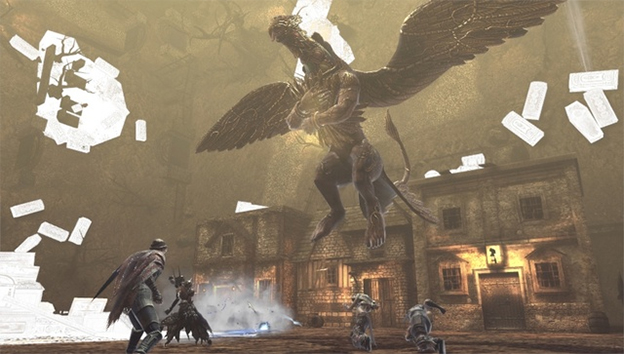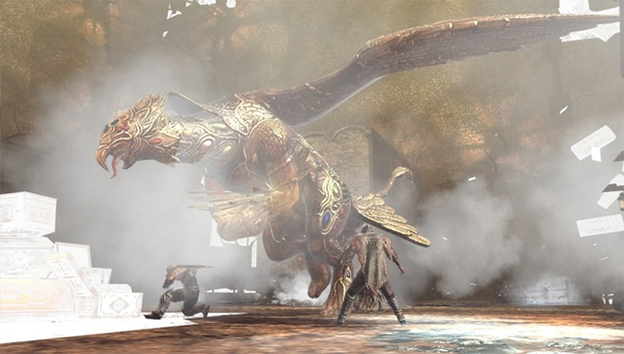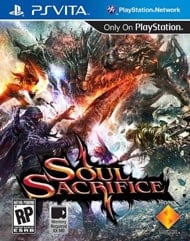The Sacrificial Lamb
I’m talking to a book.
This should seem positively absurd, but, despite a grim sense of humor that lends a small gasp of levity to the morbid proceedings, Soul Sacrifice is a game that takes itself very seriously. Unabashedly dark fantasy, the game’s title indicates its central mechanic, by which one casts violent and explosive spells through a variety of means that can include sacrificing certain attributes of your character.
Soul Sacrifice consistently demands you make choices. The game doesn’t offer the illusion of choice; these are specific, substantial decisions with immediate and observable consequences. Only rarely does Soul Sacrifice railroad you down a specific path of action, forcing you to behave in one particular manner. When it does so, though, it feels less like being locked in by invisible walls and more like the player battles against the inexorable will of destiny.

Which brings us back to the book, Librom. This demonic tome serves as a journal for an unnamed sorcerer. The player, by reading the book, relives this sorcerer’s memories from his (or her) original indoctrination into the sorcerers’ ranks. The player follows the unnamed sorcerer through the poor soul’s fateful travels with Magusar, a powerful and potentially immortal sorcerer who exists in Soul Sacrifice’s post-apocalyptic present.
Magusar is the end goal of the game, the big bad at the end of the tunnel who must be faced with the powers the player consolidates during the journey. He sacrifices others to prolong his life, locking them in cages of bone, littered with entrails and insects, until he has need of them. You belong to the ranks of the caged, potential sacrifices. You may explore your enclosure, but such confinement offers little to do. You escape your prison through the book and the battles it chronicles.
For the most part, the game consists of battle. Battle and the fully voice-acted story between. It is written from the perspective of a sorcerer whose name has long been forgotten, always assuming much and revealing little. The concealed world of Soul Sacrifice can be pieced together into a working understanding by paying attention to the details. In a world plagued by monstrous beasts, corrupted forms of everyday creatures and people, sorcerers exist solely to slaughter them. The powerful position of sorcerer bears a burden; the unique burden to each sorcerer appears as a curse centered on the right arm. Through these curses, souls are absorbed.
The tragic life of a sorcerer requires seeing the absolute worst in everything, including the one doing the seeing. This is because magic, in Soul Sacrifice, is accessed only if one offers something in return. Usually this sacrifice comes in the form of an equipped offering. These offerings allow the use of abilities that can fire saw blades, conjure elemental fists, create shields, and many more. Other abilities can be accessed by drawing from the environment in marked areas. All abilities have a limited number of uses before being exhausted. The only ability that can be used indefinitely consumes some of the player’s health with each use.

This forces the player to be constantly aware of his resources and to spend them carefully. Enemies can typically be countered mid-attack for exponentially more damage, while larger fiends have weak points that can be highlighted and targeted for increased damage and other benefits. The fact that every shot counts, though (as even the number of places at which one may “renew” offerings is limited in each encounter), adds a distinct pressure to the proceedings.
When one does manage to slay a monster, there is an immediate decision to either sacrifice or save it. The former increases one’s “soul” level while the latter increases one’s “life” level. These either increase attack or defense, respectively. Choosing one or the other will change a players “dark” or “divine” level. Balancing between the two can unlock certain bonus attributes. These attributes take the form of a permanent sigil the player’s avatar carves into his/her arm.
Building up your power, whether by increasing in level or gaining new offerings through hunting, boosting, and fusion, is important in the face of one’s end-goal: Magusar. He can be confronted at any time, but to do so before you have learned his origins would rob yourself of a story that touches on themes of identity, purpose, greed, and sacrifice. It would also be fairly difficult, because Magusar is extremely powerful.

And so you will read the book, combine your offerings, blunt them against powerful foes, gather allies through additional missions contained in other sections of the book and bring them with you as you fulfill contracts for Avalon, the organization to which all sorcerers belong. It is here that most of the game’s branching appears. Certain arch-fiends, when either sacrificed or saved, will open up different missions and close off others permanently.
Permanence defines Soul Sacrifice. Decisions you make affect what you can do going forward. Offerings, if completely expended, are broken and will not be available in future missions. Sigils consume resources as soon as they’re burned into your arm, resources which must be collected again if you wish to reapply them later. Black Rites, when activated, will disfigure your character in some way that serves as an eternal detriment. Companions, if offended by a choice you make, may part ways with you.
All of this can be undone with Lacrima, a resource one collects from a large eye on the face of the book; the amount gathered seems proportional to the number of missions completed. Lacrima repairs broken offerings, returns lost companions, and reduces the player’s soul or life level. The limit on Lacrima encourages careful consideration when making choices. Callously assuming that any decision can be undone will leave the player in a bind. One decision can be undone without Lacrima, though. The decision to sacrifice or save an archfiend can be remade by replaying the mission and choosing to overwrite the previous choice in the journal.
Soul Sacrifice is a tense game. With so much choice thrown at the player so consistently, it becomes easier and easier to make these choices, but the constant doubt of choosing correctly never really fades. There’s an intricacy to the world building here that is truly exceptional. The game would be better served, though, if that intricacy extended to the combat.
Without a variety of gameplay options, combat becomes a major factor when judging Soul Sacrifice. Since the combat is arena based, Soul sacrifice is an arena-combat game. A mission begins; there might be a small smattering of dialogue, and then you fight with the intent of slaying all monsters, killing a specific archfiend, or defeating another sorcerer. The repetitive nature of the combat makes any sustained play a chore. I often found myself wondering if I’d like the game even more with some puzzles and adventure elements alongside the combat.

Offerings, too, lack a certain something. There are a smattering of basic archetypes, within which there is a degree of variety, but it’s largely a question of which effect is being combined with which element. Getting the more powerful offerings can also be problematic, since it’s tied to how well one performs in a given level, and the scoring system is never fully outlined.
In fact, explanation is Soul Sacrifice’s biggest weakness. While this works wonders in the story itself, the various gameplay systems at work are also not fully explained, and, while the manual offers some elucidation on these matters, the bulk of the game’s intricacies must be unveiled through experimentation and blind luck. Given the permanency of decisions in Soul Sacrifice, this can be absolutely terrifying.
None of these problems deprive Soul Sacrifice of being an enjoyable, quality product. It’s an original and moody action-RPG with fast-paced, energetic combat and layers upon layers of depth to explore. That it also happens to look amazing (other than a few spots in which ground textures were somewhat pixelated) is just icing on the cake. This is, by far, one of the most solid games on the Vita.
RATING OUT OF 5 RATING DESCRIPTION 4.5 Graphics
Some of the best on the Vita, though some pixelated textures do detract in spots. 4.5 Control
Intuitive and responsive, the controls take a combat system that could have been a nightmare in its complexity and turn it into a pleasure. 4.0 Music / Sound FX / Voice Acting
The English voices might be a bit weak at times, but they’re generally enjoyable. Combat sounds are appropriately meaty and satisfying as well. 4.5 Play Value
Tons of content combines with branching paths and online play to help Soul Sacrifice deliver a tremendous amount for a single package. 4.3 Overall Rating – Great
Not an average. See Rating legend below for a final score breakdown.
| Review Rating Legend | |||
|---|---|---|---|
| 0.1 – 1.9 = Avoid | 2.5 – 2.9 = Average | 3.5 – 3.9 = Good | 4.5 – 4.9 = Must Buy |
| 2.0 – 2.4 = Poor | 3.0 – 3.4 = Fair | 4.0 – 4.4 = Great | 5.0 = The Best |
Game Features:
